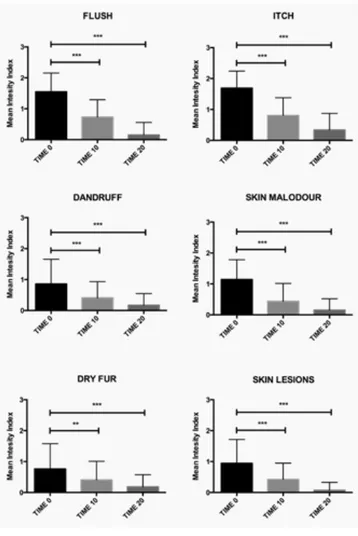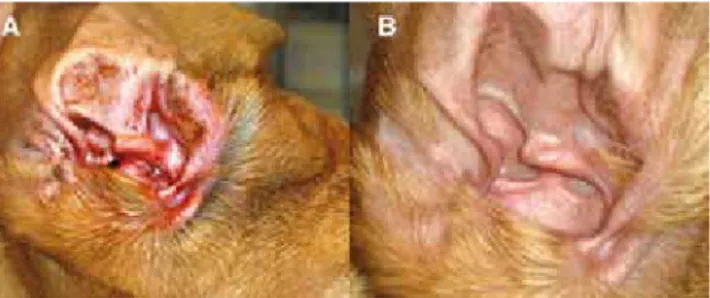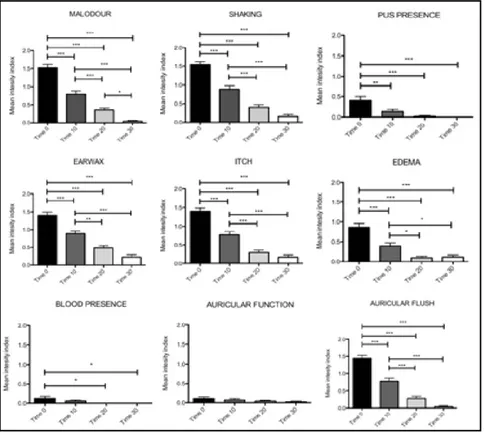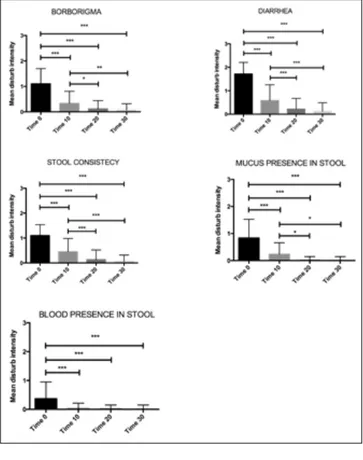KEY WORDS: functional foods, nutrition, prevention, treatment
ABSTRACT
The role of functional foods in pet diet with a perspective link with human nutrition is the object of our study. Veterinary pet trials clearly indicated that functional foods pro-vide health benefits when administered on a regular basis with adequate active principles in the context of a well balanced diet. Our work hypothesis is that domestic animals might be a suitable model to validate, in some human diseases, a specific food medi-ated approach for disease prevention and treatment, engaging the whole gut reactivity (ie, enteric hormones, chalones, cytokines, immune gastrointestinal system, lymph flow, and neurotransmitters) to rebalance the health endogenous environment.
Objective: We evaluated and analyzed the role of functional foods in pet diet in order to extend the link of food consumption in human nutrition.
Methods: We analyzed some specific
nutrients in pets on the basis of historical lit-erature reports claiming some effectiveness in cancer prevention. Other ongoing focused areas are metabolic and immunological imbalance and chronic joints inflammatory conditions.
Results: Humans and pets might have a very intriguing borderline mutual benefit in the functional food area. The activation of the digestive system involves so many changes and modifications in gastrointestinal physiology and in biochemical parameters, such as glucose and insulin, that some striking effects on health maintainance and diseases prevention are expected.
Conclusion: Based on the achieved infor-mation, we encourage the “humanization” of domestic animals as suitable models to study dietary interventions for disease prevention and treatment, keeping the concept that, being the human life span 7-8 times longer compared with the animals. Once, the ef-ficacy of the functional foods can be in very short time transferred from the animals with undeniable advantage on the life quality and
Functional Foods in Pets and Humans
Alessandro Di Cerbo
1*
Beniamino Palmieri
2Francesca Chiavolelli
3Gianandrea Guidetti
3Sergio Canello
31AIRMO Research and Development Center, via Elba 28, 20144 Milan, Italy; Tel. +393923731318, mail. [email protected];
2Azienda Ospedaliero-Universitaria Policlinico di Modena,
Surgery and Surgical Specialties department, University of Modena and Reggio Emilia, via del Pozzo 71,41124 Modena, Italy; Tel. +390594222483, mail. [email protected]; 3Sanypet, Bagnoli di Sopra, Padova, Italy; Tel. +390429785401,
mail. [email protected], [email protected], [email protected]; (*) corresponding author
overall survival. BACKGROUND Some foods and some food components have been identified as “func-tional” because they provide health benefits beyond the provision of essential nutrients such as vitamins and minerals, when they are consumed on a regular basis at effective levels as part of a varied diet.1 The
role of functional foods in human nutrition started with investigations in dogs and cats regarding nutritional genomic and proteomic studies in order to better understand the metabolism, thus optimizing companion animal nutritional and health status.2 A
human-pet comparison with regards to nutrition begins with the observation that pet owners provide their pets with alterna-tive foods (such as natural diets, raw food diets or and vegetarian diets) as if they were family members.3 This
evidence supports the concept that pathophysiological studies on pet nutrition and lifestyle might provide a valuable insight in preventing risks and illnesses regarding the family to whom the pets belong to.
Based on this nutritional philosophy, we describe here three examples of functional foods giving remarkable ben-efits to specific very common dogs diseases, affecting the human beings as well.
From the following pet animals studies we support the concept that a similar nutra-ceutical approach might be
Figure 1. Food related atopic dermatitis in a dog. (A) Before
treatment with the nutraceutical product; (B) after 20 days treat-ment.
Figure 2. Schematic representation of mean intensity
symp-tom trends at 0, 10 and 20 days of intervention; **p < 0.01; ***p < 0.001
advantageously extended in the people market, being the food itself a medicine accord-ingly with Hippocrates ancient greek doctor.
CASE 1 PRESENTATION Atopic dermatitis (AD), a chronic and relapsing com-mon eczematous skin disease, affects both humans and dogs and requires a combination of treatments. However, current
therapeutic options are unsatisfactory in both species.
Seventy-one dogs of different breeds (mean age ± SEM; 6.01 ± 0.11 yr and mean weight ± SEM; 35.04 ± 1.04 Kg; 54% males, 46% females) with clinical AD symp-toms (flush, itch, dandruff, skin malodour, dry fur, and skin lesions) were supplied with a regular amount of nutraceutical product over a 20 days period (Fig 1).
The food was a standardized mixture of fish,4 potato,5 and natural compounds
(Aloe Vera,6,7 Arctium lappa,8,9 ,Malva
sylvestris,10-13 and Ribes nigrum14,15 named
FORZA10 Dermo ActiveTM. Dogs received
four veterinary inspections, before interven-tion (time 0); after 10 days (time 10) and at the end of intervention (time 20). Forty-five dogs (63.4%) were previously fed an industrial diet: 22 (31%) a mixed one (both industrial and home-made) and 4 (5.6%) a home-made one.
Results clearly demonstrate that our nutraceutical approach halved the intensity of all investigated symptoms, related to AD, within 10 days since the beginning of the trial (Figure 2). After 20 days, the overall intensity of each symptom wad dramatically reduced.
CASE 2 PRESENTATION
The figures of human otitis externa are supposed to be 4/1,000 persons annually in USA.16 In the chronic expression, it affects
3-5% of the same population, 17-20 whereas
in the acute, which is unilateral in 90 % of cases, it affects people ranging from 7 to 12
years and declines after 50 years. The acute expression of otitis associ-ated with local trauma, warmer tempera-tures, high humidity, hearing aids, hearing protector use, and swimming.21 The most
common cause of otitis externa is infection (mainly bacterial and occasionally fungal)22
due both to increased ceruminal pH level,23
helping the microbial growth,18,21,22,24 and/or
an insufficient amount the same.21,22
Clini-cal symptoms start with pruritus, pain, and erythema. As the disease progresses to a moderate stage, the erythema increases and is followed by edema and otorrhea. The un-treated disease progresses to a more severe stage, the pain becomes intense, the lumen of the canal obstructed, ending into auricular cellulitis, parotitis or adenopathy with finally conductive hearing loss.3,6.7 However otitis
externa is also one of the more frustrat-ing pathology affectfrustrat-ing also pets.25 Current
antimicrobial therapy rely on polymyxin B and miconazole, which resulted to be effective against the main bacterial patho-gens (Staphylococcus spp, Pseudomonas
aeruginosa, Escherichia coli and Proteus mirabilis).26-29
One hundred seven dogs of different breeds (mean age ± SEM; 6.03 ± 0.15 yr and mean weight ± SEM; 32.01 ± 1.17 Kg; 54.2% males, 45.8% females) with evident clinical chronic otitis externa symptoms received a regular amount of nutraceutical food over a 30 days period (Figure 3).
The nutraceutical product consisted in a standardized mixture of fish and natu-ral compounds (Melaleuca alternifolia,
Figure 3. Food related otitis media in a dog. (A) Before
treatment with the nutraceutical product; (B) after 30 days treatment.
Echinacea purpurea, Tilia platyphyllos scapoli et cordata, Allium sativum L., Rosa canina L. and chelated Zinc) named
FORZA10 Oto ActiveTM. Dogs received four
veterinary inspections, before intervention (time 0); after 10 days (time 10); after 20 days (time 20); and at the end of interven-tion (time 30). Sixty four dogs (60%) were previously fed an industrial diet:; 35 (32%) a
mixed one (both industrial and home-made); and 9 (8%) a home-made one.
Our study clearly demonstrated that clinical benefits were achieved for each symptom, except for auricular function, within 10 days of dietary intervention.
Diet is a significant therapeutic option for dogs with otitis who become generally quite aggressive and definitely refuse topical treatments. The product that we used can be considered a useful tool to manage such inflammatory condition (Figure 4).
CASE 3 PRESENTATION
Food allergic reactions, which may include signs of cutaneous and gastrointestinal disease, usually occur following ingestion of the food allergen to which the individual is sensitive, causing immediate and late-phase reactions. Adverse reactions to food (ARF) are known to manifest primarily with gastrointestinal symptoms,30,31 and are also
associated with irritable bowel syndrome, or might be a mechanism for symptoms in a subgroup of afflicted patients.32-34 Typical
signs of food-related gastrointestinal distur-bances in humans, for instance, are emesis, diarrhoea, abdominal pain, urticaria angio-edema, asthma, rhinitis and, in severe cases, anaphylaxis,35,36 and are usually treated
avoiding food allergens, although support-ive medical treatment can be beneficial for severe reactions.37
Food allergies are known to cause both
Figure 4. Schematic representations of the trend of the symptoms intensity index at 0, 10, 20
dermatologic and gastrointes-tinal disturbances in dogs. 33,37-39 Most common food
aller-gens in dogs are lamb, poultry, dairy products, egg, barley, wheat, beef, and fish.40-43 The
gold-standard method to diag-nose an adverse food reaction consists in limiting the antigen exposure for a 8-10-week period, and then reintroduc-ing the diet previously fed to demonstrate a relapse of symptoms.44
Both home-cooked and commercial diets contain a single source of protein and a single source of carbohydrate, which are usually not used in maintenance diets thus reduc-ing the probability that animal had ever come into contact with them before.45 A valid
alternative to novel protein diets are the hydrolysed pro-tein based ones, because they are made of protein fragments with molecular weights of < 10 kDa that confer higher digestibility and lower al-lergenicity.46
Sixty dogs of different breeds (mean age ± SEM; 6.08 ± 0.14 yr and mean weight ± SEM; 32.05 ± 1.12 Kg; 55% males, 45% females) with clinical gastrointestinal disturbs (dehydration, appetite loss, regur-gitation, emesis, abdominal pain, flatulence, borborygma, diarrhea, weight loss, stool consistency, blood, and mucus presence in the stool) were supplied with a regular amount of nutraceutical product over a 30-day period.
Results clearly demonstrated that the nutraceutical product halved the intensity of each gastrointestinal disturbances within 10 days since the beginning of the trial (Figure 5a-5b). Moreover, after 20 days, the overall intensity of each symptom was dramatically reduced.
CONCLUSIONS
The lesson of functional foods administra-tion to the dogs might prospectively be addressed to human beings in a very short time. Chronic food ingestion might in fact modify the genetic background and pre-vent or treat many diseases, rather than acute drugs administration attempting at modifying the body imbalance due to the illness process, without interfering with the organism which is supposed to be simply an innocent bystander.
Functional foods, on the contrary, involve an active interaction between the digestive apparatus and the defense against pathogen agents or morbility causes on a very much integrated basis. In fact, the gut absorption is a complex effector pathway with intrinsic healing properties related to gut hormones liver and biliopancreatite
Figure 5a. Schematic representations of the trend of the
symptoms intensity index at 0, 10, 20 and 30 days of inter-vention; *p < 0.05; **p < 0.01; ***p < 0.001.
enzymes secretion haemodynamics, and lymphodynamics modification namely to microcirculation activity, gut cellular, and soluble immune systems, cytokines, micro-biota neural network and neutrotransmitters.
Such a complex involvement is quite appealing for health restoration process and our scientific strategy will go deep into this fascinating potential based on the natural re-sources of herbs plants, fruits and microbes. LIST OF ABBREVIATIONS
AD = atopic dermatitis
ARF = Adverse reactions to food
COMPETING INTEREST We achieved from the Sany-pet company the food for our studies free of charge, but the whole investigation has been run without financial support exclusively as animal model for future development of similar nutrients in the humans. AUTHORS’ CONTRIBUTIONS ADC, FC, GG and BP con-ceived of the study, and partici-pated in its design and coordi-nation and helped to draft the manuscript; SC carried out the animal food administration and veterinary visits. All authors read and approved the final manuscript.
REFERENCES
1. Hasler CM: The changing face of functional foods. Journal of the
American College of Nutrition 2000,
19:499s-506s.
2. Swanson KS, Schook LB, Fahey GC, Jr.: Nutritional genomics: implica-tions for companion animals. The
Jour-nal of nutrition 2003, 133:3033-3040.
3. Michel KE: Unconventional diets for dogs and cats. The Veterinary clinics of North America Small animal practice 2006, 36:1269-1281, vi-vii.
4. Landis ET, Davis SA, Feldman SR, Taylor S: Complementary and Al-ternative Medicine Use in Dermatology in the United States. Journal of
alterna-tive and complementary medicine (New
York, NY) 2014.
5. Burks AW, James JM, Hiegel A, Wilson G, Wheel-er JG, Jones SM, ZuWheel-erlein N: Atopic dWheel-ermatitis and food hypersensitivity reactions. The Journal of
pediatrics 1998, 132:132-136.
6. Dohil MA: Natural ingredients in atopic dermatitis and other inflammatory skin disease. Journal of
drugs in dermatology : JDD 2013, 12:s128-132.
7. Kim J, Lee I, Park S, Choue R: Effects of Scutel-lariae radix and Aloe vera gel extracts on immuno-globulin E and cytokine levels in atopic dermatitis NC/Nga mice. Journal of ethnopharmacology 2010, 132:529-532.
8. Sohn EH, Jang SA, Joo H, Park S, Kang SC, Lee CH, Kim SY: Anti-allergic and anti-inflammatory effects of butanol extract from Arctium Lappa L. Figure 5b. Schematic representations of the trend of the
symptoms intensity index at 0, 10, 20 and 30 days of inter-vention; *p < 0.05; **p < 0.01; ***p < 0.001.
Clinical and molecular allergy : CMA 2011, 9:4.
9. Chan YS, Cheng LN, Wu JH, Chan E, Kwan YW, Lee SM, Leung GP, Yu PH, Chan SW: A review of the pharmacological effects of Arctium lappa (bur-dock). Inflammopharmacology 2011, 19:245-254. 10. Graf J: Herbal anti-inflammatory agents for skin
disease. Skin therapy letter 2000, 5:3-5.
11. Conforti F, Sosa S, Marrelli M, Menichini F, Statti GA, Uzunov D, Tubaro A, Loggia RD: In vivo anti-inflammatory and in vitro antioxidant activi-ties of Mediterranean dietary plants. Journal of
ethnopharmacology 2008, 116:144-151.
12. Fujii M, Nakashima H, Tomozawa J, Shimazaki Y, Ohyanagi C, Kawaguchi N, Ohya S, Kohno S, Nabe T: Deficiency of n-6 polyunsaturated fatty acids is mainly responsible for atopic dermatitis-like pruritic skin inflammation in special diet-fed hairless mice. Experimental dermatology 2013, 22:272-277.
13. Gasparetto JC, Martins CA, Hayashi SS, Otuky MF, Pontarolo R: Ethnobotanical and scientific aspects of Malva sylvestris L.: a millennial herbal medicine. The Journal of pharmacy and
pharma-cology 2012, 64:172-189.
14. Linnamaa P, Savolainen J, Koulu L, Tuomasjukka S, Kallio H, Yang B, Vahlberg T, Tahvonen R: Blackcurrant seed oil for prevention of atopic der-matitis in newborns: a randomized, double-blind, placebo-controlled trial. Clinical and experimental allergy : journal of the British Society for Allergy
and Clinical Immunology 2010, 40:1247-1255.
15. Caruso M, Frasca G, Di Giuseppe PL, Pennisi A, Tringali G, Bonina FP: Effects of a new nutraceuti-cal ingredient on allergen-induced sulphidoleukot-rienes production and CD63 expression in allergic subjects. International immunopharmacology 2008, 8:1781-1786.
16. Osguthorpe JD, Nielsen DR: Otitis externa: Re-view and clinical update. American family
physi-cian 2006, 74:1510-1516.
17. Sood S, Strachan DR, Tsikoudas A, Stables GI: Allergic otitis externa. Clinical otolaryngology and allied sciences 2002, 27:233-236.
18. Daneshrad D, Kim JC, Amedee RG: Acute otitis externa. The Journal of the Louisiana State Medi-cal Society : official organ of the Louisiana State Medical Society 2002, 154:226-228.
19. Hannley MT, Denneny JC, 3rd, Holzer SS: Use of ototopical antibiotics in treating 3 common ear diseases. Otolaryngology--head and neck surgery : official journal of American Academy of Otolaryngology-Head and Neck Surgery 2000, 122:934-940.
20. Agius AM, Pickles JM, Burch KL: A prospective study of otitis externa. Clinical otolaryngology and
allied sciences 1992, 17:150-154.
21. Beers SL, Abramo TJ: Otitis externa review.
Pedi-atric emergency care 2004, 20:250-256.
22. Sander R: Otitis externa: a practical guide to treat-ment and prevention. American family physician 2001, 63:927-936, 941-922.
23. Halpern MT, Palmer CS, Seidlin M: Treatment patterns for otitis externa. The Journal of the
American Board of Family Practice / American Board of Family Practice 1999, 12:1-7.
24. Tsikoudas A, Jasser P, England RJ: Are topical antibiotics necessary in the management of otitis externa? Clinical otolaryngology and allied
sci-ences 2002, 27:260-262.
25. Pietschmann S, Meyer M, Voget M, Cieslicki M: The joint in vitro action of polymyxin B and mi-conazole against pathogens associated with canine otitis externa from three European countries.
Vet-erinary dermatology 2013, 24:439-445, e496-437.
26. Engelen M, De Bock M, Hare J, Goossens L: Ef-fectiveness of an Otic Product Containing Micon-azole, Polymyxin B and Prednisolone in the Treat-ment of Canine Otitis Externa: Multi-site Field Trial in the US and Canada. International Journal
of Applied Research in Veterinary Medicine 2010,
8:21.
27. Engelen MA, Anthonissens E: Efficacy of non-acaricidal containing otic preparations in the treatment of otoacariasis in dogs and cats. The
Veterinary record 2000, 147:567-569.
28. Studdert VP, Hughes KL: A clinical trial of a topical preparation of miconazole, polymyxin and prednisolone in the treatment of otitis externa in dogs. Australian veterinary journal 1991, 68:193-195.
29. Rougier S, Borell D, Pheulpin S, Woehrle F, Bois-rame B: A comparative study of two antimicrobial/ anti-inflammatory formulations in the treatment of canine otitis externa. Veterinary dermatology 2005, 16:299-307.
30. Sicherer SH: Clinical aspects of gastrointesti-nal food allergy in childhood. Pediatrics 2003, 111:1609-1616.
31. Crespo JF, Rodriguez J: Food allergy in adulthood.
Allergy 2003, 58:98-113.
32. Stefanini GF, Saggioro A, Alvisi V, Angelini G, Capurso L, di Lorenzo G, Dobrilla G, Dodero M, Galimberti M, Gasbarrini G, et al.: Oral cromolyn sodium in comparison with elimination diet in the irritable bowel syndrome, diarrheic type. Multi-center study of 428 patients. Scandinavian journal
of gastroenterology 1995, 30:535-541.
33. Niec AM, Frankum B, Talley NJ: Are adverse food reactions linked to irritable bowel syndrome?
The American journal of gastroenterology 1998,
93:2184-2190.
34. Iacono G, Cavataio F, Montalto G, Florena A, Tumminello M, Soresi M, Notarbartolo A, Car-roccio A: Intolerance of cow’s milk and chronic constipation in children. The New England journal
of medicine 1998, 339:1100-1104.
35. Metcalfe DD: Immune mechanisms in food allergy. Clinical and experimental allergy : journal of the
British Society for Allergy and Clinical Immunol-ogy 1991, 21 Suppl 1:321-324.
36. Sampson HA: Food allergy. Part 1: immuno-pathogenesis and clinical disorders. J Allergy Clin
Immunol 1999, 103:717-728.
37. Bischoff S, Crowe SE: Gastrointestinal food allergy: new insights into pathophysiology and clinical perspectives. Gastroenterology 2005,
128:1089-1113.
38. Kang MH, Park HM: Putative peanut allergy-in-duced urticaria in a dog. The Canadian veterinary
journal La revue veterinaire canadienne 2012,
53:1203-1206.
39. Walton GS: Skin responses in the dog and cat to ingested allergens. Observations on one hundred confirmed cases. The Veterinary record 1967, 81:709-713.
40. Jeffers JG, Meyer EK, Sosis EJ: Responses of dogs with food allergies to single-ingredient dietary provocation. Journal of the American Veterinary
Medical Association 1996, 209:608-611.
41. Verlinden A, Hesta M, Millet S, Janssens GP: Food allergy in dogs and cats: a review. Critical reviews
in food science and nutrition 2006, 46:259-273.
42. Kennis RA: Food allergies: update of pathogenesis, diagnoses, and management. The Veterinary clinics
of North America Small animal practice 2006,
36:175-184, vii-viii.
43. Gaschen FP, Merchant SR: Adverse food reactions in dogs and cats. The Veterinary clinics of North
America Small animal practice 2011, 41:361-379.
44. Scott DW, Miller WHJ, Griffin CE: Muller and
Kirk’s Small Animal Dermatology. 6th edn: SAGE
Publications; 2001.
45. Jackson HA: Diagnostic techniques in dermatol-ogy: the investigation and diagnosis of adverse food reactions in dogs and cats. Clinical techniques
in small animal practice 2001, 16:233-235.
46. Cave NJ: Hydrolyzed protein diets for dogs and cats. The Veterinary clinics of North America Small



